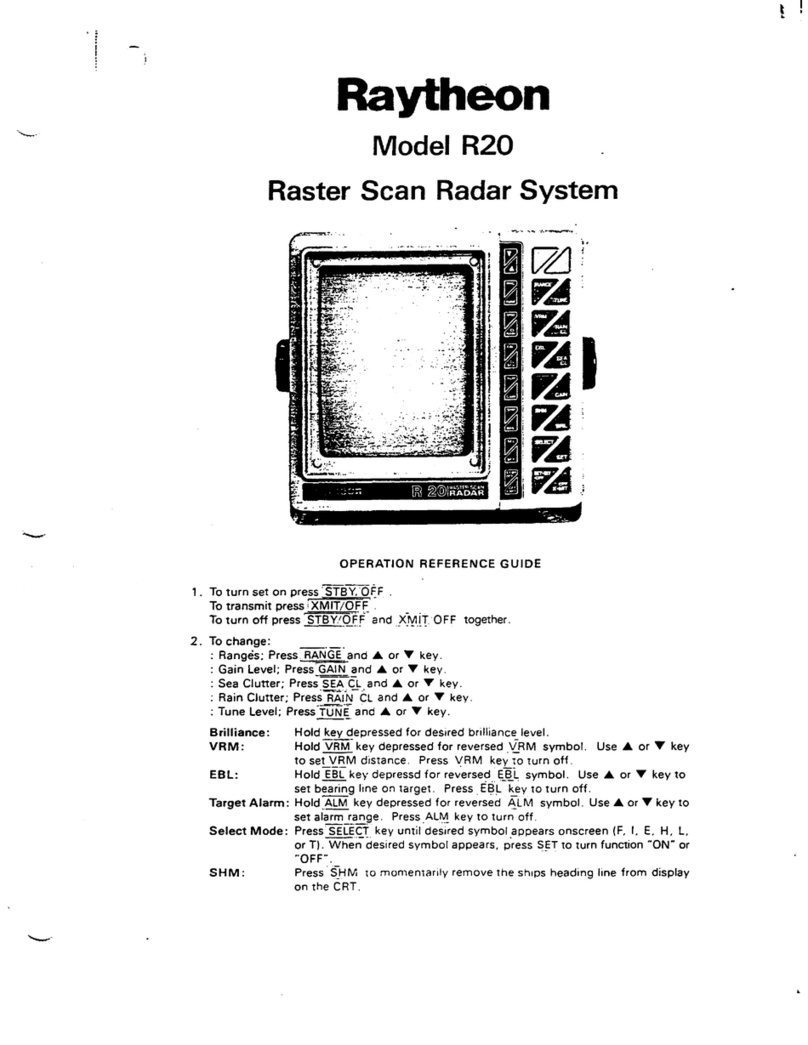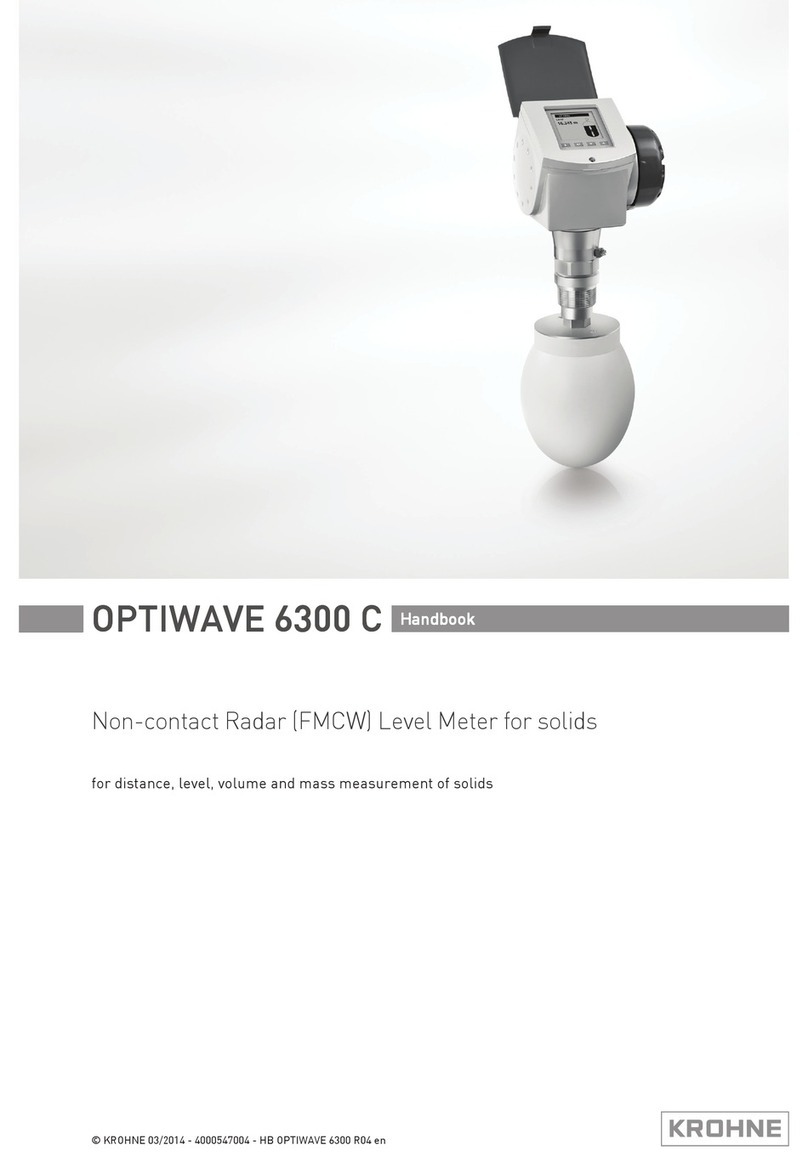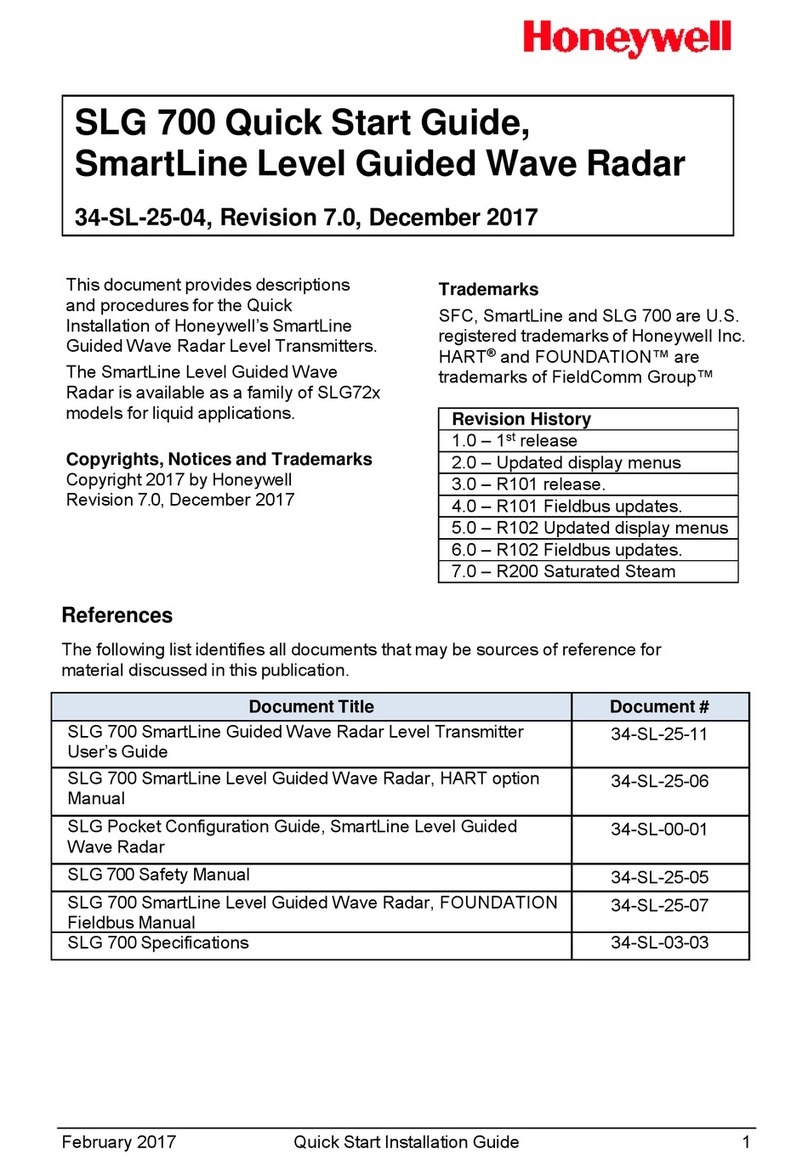Noptel speeder x1 User manual

Speeder X1 and X2
Laser Radar
Configuration and API Guide

____________________________________________________________________________________
____________________________________________________________________________________
Speeder X1 and X2 Configuration and API Guide Page 2/36

____________________________________________________________________________________
____________________________________________________________________________________
Speeder X1 and X2 Configuration and API Guide Page 3/36
Contact information
Noptel Oy
Address: Teknologiantie 2
FI-90590 Oulu
Finland
Tel.: +358 40 181 4351
Fax: +358 8 556 4101
E-mail: [email protected]
Technical support: see our Web site: www.noptel.fi
Downloads:
Documents :
http://www.noptel.fi/eng/nms/index.php?doc=7_downloads/5_manuals&group=MSC
Software:
http://www.noptel.fi/eng/nms/index.php?doc=7_downloads/7_software&group=MSC
Firmware:
Document Information :
Document Title: Speeder X1 and X2 Configuration and API Guide
Document Version: 1.4
Released: (25.04.2014)
Current printing 25.4.2014
Document ID: N42272AE
Document Status: Release
Firmware version CM5: 5.00.45 (CMS5)
Copyright Notice:
Specifications and implementation are subject to change without notice due to continuous
research and development.
Copyright © 2013 Noptel Oy, Oulu, Finland

____________________________________________________________________________________
____________________________________________________________________________________
Speeder X1 and X2 Configuration and API Guide Page 4/36
1INTRODUCTION TO THE FAST RANGEFINDERS............................................................... 5
1.1 INTRODUCTION............................................................................................. 5
1.2 COMMUNICATION PROTOCOL......................................................................... 5
1.3COMMANDS IN CONFIGURATION MODE ........................................................... 6
2OPERATION MODES.............................................................................................................. 9
2.1 LIST OF OPERATION MODES........................................................................... 9
2.2OUTPUT AT STARTING OF THE OPERATION MODE ........................................... 10
3DISTANCE MEASUREMENTS ............................................................................................. 11
3.1 ASCII MODE.............................................................................................. 11
3.1.1 ASCII format of the distance measurement......................................... 11
4SPEED MEASUREMENTS ................................................................................................... 13
4.1 SPEED MEASUREMENT MODE FOR VERTICAL INSTALLATION ............................ 13
4.1.1 Speed calculation method ................................................................... 17
4.1.2 Delayed trigger in speed measurement............................................... 17
4.2 MULTILANE SPEED MEASUREMENT MODE...................................................... 19
4.3 AUTOMATIC SETTING OF THE MEASUREMENT WINDOW ................................... 22
4.3.1 Vertical setup....................................................................................... 22
4.3.2 Horizontal setup................................................................................... 23
5DETECTION MODES ............................................................................................................ 24
5.1 TRIGGER WINDOW MODE............................................................................. 24
5.1.1 In window and Out of window triggering.............................................. 25
5.1.2 Trigger count and timing information ................................................... 26
6PARAMETERS ...................................................................................................................... 27
6.1 USER PARAMETER COMMANDS .................................................................... 27
6.2 PERMANENT MEMORY PARAMETERS............................................................. 29
6.3 PARAMETER LIST........................................................................................ 29
6.4 CONTROL BYTE 1....................................................................................... 33
6.5 CONTROL BYTE 2....................................................................................... 33
6.6 CONTROL BYTE 3....................................................................................... 34
6.7 CONTROL BYTE 4....................................................................................... 34
6.8 CONTROL BYTE 5....................................................................................... 35

____________________________________________________________________________________
____________________________________________________________________________________
Speeder X1 and X2 Configuration and API Guide Page 5/36
1 INTRODUCTION TO THE FAST RANGEFINDERS
1.1 Introduction
This document presents Configuration and Application programming interface (API) for
Speeder X1 and X2 Laser Radars which are based on Noptel’s fast rangefinder
technology. Connections and hardware of the sensors is presented in ”CM5 Technical
manual”.
Speeder is designed for Speed measurement but it is also suitable for Distance
Measurement and Target Detection. Versatile utilization of sensors leads to diverse
Configuration and Parameterization. The document is intended as facilitate the work.
1.2 Communication protocol
Baud rates:
The sensors operate connected to the RS-232 or RS-422 port, using baud rates of 1200
to 921600 bd.
The bit stream of serial port consists of:
Data bits
8
Parity
None
Stop bit
1
Flow Control
None
The main commands of the sensor are described in this chapter. The default baud rate is
9600. If the baud rate is not known, the user can reset the baud rate to 9600 by sending
multiple <esc>’s to the serial port, while connecting power on to the sensor.
The ASCII command protocol is in the form:
<esc>[Device Number]<Command><Value1>,<Value2><cr>
Where
<esc> ASCII code 27
[Device Number] is an option, 1–9 if two or more sensors are connected to a serial port,
Command is a command according to the Chapter 1.3,
<Value1> and <Value2>are parameter No. and values in ASCII format (if needed), and
<cr> is Carriage Return (ASCII code 13).
The controller must be in Configuration Mode (par. #1 = 0) when giving commands. The
character <esc> is used for returning the sensor to base state.

____________________________________________________________________________________
____________________________________________________________________________________
Speeder X1 and X2 Configuration and API Guide Page 6/36
<esc> has three basic functions:
1. Precedes every command.
2. Deletes wrong command.
3. Returns the Sensor into Configuration Mode.
Echo mode:
The system has two communication modes: echo and no echo. In echo mode the
commands and numbers will be echoed back to allow easier operation with terminal
software. Characters prior <esc> are not echoed. In no-echo mode no characters or
numbers are echoed. The echo mode can be defined by Commands [i], echo OFF and
[I], echo ON. These commands will assign bit 1 of Control Byte 2 respectively.
Start-up:
The sensor starts to operate always in the mode according to parameters in the
permanent parameter memory. Parameters are changeable, but before saving
parameters into the permanent memory, user should always test the proper function of
the sensor.
1.3 Commands in Configuration mode
The commands in Configuration mode are as follows:
Command
Description
Answer
c
Measure distance once
Dxxxxx [aaaaa] 1)
C
Measure distance continuously, until next <esc>
Dxxxxx [aaaaa] 1)
Dxxxxx [aaaaa] ....
d
Return error list of the Sensor
Error table 2)
G
Reset the Sensor
GOK 3)
H<Value>
Return <Value> count of distance measurement
results (in ASCII format, average parameter used)
HDxxxxx aaaaa 1)
Dxxxxx aaaaa ....
ERRCNT=y
i
Set serial port echo OFF
ECHO OFF
IOK
I
Set serial port echo ON (Capital I)
ECHO ON
IOK
J<0/1>
1 = Continuous laser pulsing ON
0 = Laser pulsing OFF
During laser pulsing trigger output will toggle with each
pulse. Feature can be used to check the accuracy of
the system time base. The pulse rate is defined by
parameters 4 and 5 (See chapter 6.3)
1
0
L<No.>
Read the used value of the parameter No.
Lxxxxx
L
Read all used parameters
L0001 xxxxx
L0002 xxxxx
….
LW<No.>
Read word (16 bits) parameter from location No. and
No.+1
Lxxxxx
M
Use the set measurement mode as defined in
parameter 1.
MOK
M<No.>
Use measurement mode No.
MOK

____________________________________________________________________________________
____________________________________________________________________________________
Speeder X1 and X2 Configuration and API Guide Page 7/36
O<0/1>
0 = pointer OFF, 1 = pointer ON
OOK
P<No.>
Read the value in EPROM of the parameter No.
Pxxxxx
S
Save user parameters to permanent memory
(X must be used before)
SOK
T<No.>,<Value>
Write <Value> to the parameter <No.> (ram)
TOK
TW<No.>,<Value
Write integer <Value> (0-65535) to parameter <No.>
and <No.>+1
TOK
v (lower case)
Sensor information in the Noptel internal format
V (upper case)
Sensor information in ASCII format (version)
Sensor information 4)
V1
Read voltage, current and temperature measurements
Table 5)
V2
Perform self-test and show its result
OK or
Explanation of the
error and ERR:xxxxx
X
Enable writing to permanent memory
WR ENABLE
Commonly used commands in configuring the sensor for applications are light blue.
The end of the line of answer is always <cr><lf>.
1) Distance measurement commands
Commands c and C, return results according to Chapter 3.1.
With command H it’s the same except Amplitude Output Enable does not have an effect
but amplitude is given in any case.
2) Error table (example) (table is for diagnostic purposes only and it is updated
during every power-up of the sensor)
Code Error Error count
0001 EEPROM R/W : 0
0002 TDC datardy : 0
0004 RX Error : 0
0008 TDC main counter : 0
0010 TDC interpolator : 0
0020 Low battery : 0
0040 Supply voltage! : 0
0080 Invalid value : 0
0100 Unknown command : 0
0200 TDC interp zero : 0
0400 EEPROM/FLASH:CRC? : 0
0800 Voltage error! : 0
1000 APD voltage! : 0
2000 Temperature! : 0
4000 Power consumption! : 0
8000 HV error! : 0
OK
Some errors may occur in certain conditions, like too low supply voltage or too high/low
operating temperature. If the operation of the sensor returns to normal and errors do not
keep increasing, it is safe to continue using the sensor. Otherwise contact Noptel Oy for
further information.

____________________________________________________________________________________
____________________________________________________________________________________
Speeder X1 and X2 Configuration and API Guide Page 8/36
3) Sensor information at Power-up and after Resetting
9600 (Baud Rate)
EEPROM PARAMS RESTORED
SPEEDER X1
CMS5012242,RS232
Noptel Oy
ParamDate:2012.04.20
Version :5.00.50 BAF3h
SW Date :Dec 14 2012
SW time :12:51:12
Ubat :10.3 V
READY!
4) Sensor information <esc>V<cr>
An example of answer for command V:
SPEEDER X1
CMS5012242,RS232
Noptel Oy
ParamDate:2012.04.20
Version :5.00.50 BAF3h
SW Date :Dec 14 2012
SW time :12:51:12
Ubat :11.4 V
OK
The order of lines varies according to the firmware version of the Sensor.
5) Voltage, current and temperature table (table is for diagnostic purposes only)
An example of answer for command V1 is presented below (units are added):
Description Value Unit (Not in output)
APD :02212 [0.1V]
RX temp :03222 [0.01°C]
RX Anaout :0156 [mV]
Current :00201 [mA]
VDD :05068 [mV]
VAN :02960 [mV]
VTDC :04845 [mV]
CP temp :02540 [°C]
UBAT :10293 [mV]
UDCDC :0548 [mV]
VRX :05161 [mV]
VOSC :05022 [mV]
VTX :05138 [mV]
VCP :03348 [mV]
TXHV :00257 [V]
TX temp :02311 [0.01°C]
OK

____________________________________________________________________________________
____________________________________________________________________________________
Speeder X1 and X2 Configuration and API Guide Page 9/36
2 OPERATION MODES
2.1 List of operation modes
0 ASCII mode / Configuration Mode (Chapter 3.1)
The Sensor sends measurement results in ASCII format according to the user’s
commands and parameter settings. In this mode the sensor receives commands like
parameter change and state control or operation mode selection.
1 Continuous ASCII mode (Chapter 3.1)
The sensor sends measurement results in ASCII format continuously according to the
parameter settings.
5 Trigger window mode (Chapter 5.1)
The sensor controls the measurement results in the trigger window, and according to
parameters it gives trigger-output-signal and sends trigger distance to serial-port. In this
mode the Speeder sensor operates with one laser for accurate detection.
7 Speed measurement mode for vertical installation (Chapter 4.1)
The sensor waits for the target to be in the trigger window and then starts measuring the
change of distance to the target in the selected windows. Speeder X1 comprises two
integrated laser transmitters with a small angle, allowing measurement of two
consecutive overlapping speed profiles from the vehicle.
12 Speed measurement mode for horizontal installation (Chapter 0)
The mode is designed to be used from the side of the road at the level of vehicles. The
mode gives possibility to catch speed of vehicles travelling on one or multiple lanes.

____________________________________________________________________________________
____________________________________________________________________________________
Speeder X1 and X2 Configuration and API Guide Page 10/36
2.2 Output at starting of the operation mode
Output of the sensor after mode command (<esc>M<No.><cr>) are following:
Mode <No.>
Output
0
MOK, no effect
1
MOK
Dxxxxx [aaaaa]
Dxxxxx [aaaaa] ....
5 (example)
MOK
TRIGGER MODE
TRIG IN 500–550 cm
ESC to EXIT
7 (example)
MOK
Speeder X1 SPEED MODE
Approaching vehicles
MASTER DISTANCE 3059 cm
SLAVE DISTANCE 2860 cm
ESC to EXIT
12 (example)
MOK
HORIZONTAL INSTALLATION (MULTILANE)
Speeder X1 SPEED MODE
Approaching vehicles
MASTER DISTANCE 3500 cm
SLAVE DISTANCE 3279 cm
ESC to EXIT

____________________________________________________________________________________
____________________________________________________________________________________
Speeder X1 and X2 Configuration and API Guide Page 11/36
3 DISTANCE MEASUREMENTS
3.1 ASCII Mode
The value of the Parameter 1 is 0 (= single) or 1 (= continuous).
In this mode the sensor measures the distance to the target either after the detection of
<space> character or by the activation of Digital-input-signal or by the user command (c
or C). Serial port communication is in ASCII format. The maximum measurement speed
in ASCII mode depends on the communication speed and parameter settings.
Continuous mode can be activated by command <esc>M1<cr> or <esc>M<cr> if value of
par. #1 is 1.
Parameters related to ASCII mode are:
No.
Type
Name / Description
Unit
Range
Default
1
B
Operation Mode
0 or 1
2
B
Control Byte 1
b4
Hardware Input Disable
0
3
B
Control Byte 2
b2
Decimal Enable
0
b3
Amplitude Output Enable
1
b5
Fast Key Disable
0
4
B
Baud Rate
1 - 10
4
5,6
W
Pulse Rate
Hz
1-2000
2000
7
B
Averaging
2n
0 - 14
4
8
B
Attenuation
0 - 15
0
11
B
Device Number
0 - 9
0
47
B
Laser Control
0,1,2
2
3.1.1 ASCII format of the distance measurement
The data in ASCII mode is delivered in the following format:
Distance result from the sensor
Dzxxxxx[.d]<space>[aaaaa]<cr><lf>
z is automatically added number for values > 99m
xxxxx is distance in millimetres,
.d is the decimal digit (option),
aaaaa is the signal amplitude value (option)
The answer format depends on Decimal Enable in Control Byte 2 (Bit 2) as follows:
“1”: Dxxxxx.x aaaaa.a “0”: Dxxxxx aaaaa
Received signal amplitude (aaaaa) is sent if Amplitude Output is Enabled (Control Byte 2,
Bit 3 = 1). It can be used for analyzing a quality of measurement. The higher the value,
the better quality of a distance measurement result. The range is a few tens up to 1300.

____________________________________________________________________________________
____________________________________________________________________________________
Speeder X1 and X2 Configuration and API Guide Page 12/36
D00000 refers to a failed distance measurement in the case of which the amplitude value
carries an error code. The Code is given only if the Amplitude Output is Enabled (Control
Byte 2, Bit 3 = 1).
Error messages in ASCII distance measurement mode:
Hex value
Dec val.
Error
1
1
EEPROM R/W error
2
2
No object
4
4
Receiver error
8
8
TDC counter error 1
10
16
TDC counter error 2
20
32
Low battery
40
64
Supply voltage
80
128
Invalid value
100
256
Unknown command
200
512
TDC counter error 3
400
1024
EEPROM or FLASH Checksum error
800
2048
Voltage error
1000
4096
APD voltage error
2000
8192
Temperature
4000
16384
Power consumption
8000
32768
High Voltage error

____________________________________________________________________________________
____________________________________________________________________________________
Speeder X1 and X2 Configuration and API Guide Page 13/36
4 SPEED MEASUREMENTS
4.1 Speed measurement mode for vertical installation
The value of the Parameter 1 is 7.
Fig. 1. An example of speed measurement using Speeder X1 laser radar. Speeder X1 has two
separate laser beams A and B.
The geometry of the measurement is recommended to be >5:1 (please see the Fig. 1): For example, if the
sensor is at 5 m height it should be aimed to at least to 25 m distance in order to achieve good speed
measurement readings.
Fig. 2. Default orientation of the Speeder X1 laser radar for vertical installation is laser radiation
sticker up. When orientation is changed parameter 53 must be set correspondingly.
Setup in Fig. 1 and Fig. 3 applies for controlling of one lane per sensor. The sensor is aimed
at the centre of the lane for desired distance. Furthermore, the sensor comprises a laser
pointer, which can be used to set correct alignment. The laser pointer has poor visibility
at bright daylight and when used in fixed installation with a camera it is advised to align
the sensor with the camera at indoors. This enables the final aiming with the help of the
camera.
1
5
Speeder

____________________________________________________________________________________
____________________________________________________________________________________
Speeder X1 and X2 Configuration and API Guide Page 14/36
The best accuracy is achieved when the sensor measures as far as possible with
reasonable signal level. The distance to the vehicle can be up to 40 to 90 metres, when
the register plate is reflective, and up to 30 metres without reflective register plates. To
achieve proper illumination for LPR-camera it is sometimes necessary to use shorter
distance. Another option is to use delayed trigger, which is described in paragraph 4.1.2.
The speed of both approaching and departing vehicles can be measured. The selection of the direction is
done by Bit 5 of Control Byte 1.
Fig. 3. Detection of vehicle with Speeder X1 laser radar affixed on gantry above the lane.
Speed measurement starts with detection of the vehicle when trigger is first activated in
the trigger window. Trigger activation is achieved when amount of the distance results
reaches the hits for trig parameter’s value. After detection sensor measures distance to
the target until vehicle has passed and calculates the speed of the target. The accuracy
for the speed measurement is better than ±2 km/h (±2% for over 100 km/h speeds), when
the measurement beam hits the vehicle (which travels on the lane, not on the side of it).
In order to use the mode user must set following parameters:
No.
Type
Name / Description
Unit
Range
Default
1
B
Operation Mode
7
2
B
Control Byte 1
b5
Speed Behind
0
4
B
Baud Rate
1 - 10
4
5,6
W
Pulse Rate
Hz
1 - 2000
2000
8
B
Attenuation
0 - 15
0
9,10
W
Trigger Distance B
cm
600 - 38000
12,13
W
Trigger Distance A
cm
600 - 38000
29,30
W
Speed Pulse Rate (Note 1)
Hz
0 - 8000
4000
32
B
Speed Geometry (Note 2)
dm
53
B
Sensor Orientation
0,1,2
1
Note 1: Speed pulse rate is in use after detection of a vehicle in speed measurement application (or
mode). Speeder X1 is class 1 laser product. Eye-safety standard limits the pulse rate of Speeder X1 to
2000 Hz for pulse trains in short range (Condition 2, target distance less than 2 meters). Laser pulsing
exceeding 2000 Hz is allowed only while measured distance is more than 2 meters. Pulse train limitations
are controlled programmatically to fulfil the Standard EN 60825-1:2007 (IEC 60825-1:2007) Condition 2.
Note 2: The height of the sensor position is utilized to calculate measurement windows for both lasers
according to the geometry of the measurement set-up. The user must set this parameter accordingly to
achieve accurate speed measurement results.

____________________________________________________________________________________
____________________________________________________________________________________
Speeder X1 and X2 Configuration and API Guide Page 15/36
Advanced configuration parameters for above the road operation:
No.
Type
Name / Description
Unit
Range
Default
14
B
Trigger Window Width
dm
1 - 255
51
15
B
Hits For Trig
smpls
1 - 255
10
17
B
Trigger Length (Note 3)
ms
1 - 255
255
18
B
Clear Check Time
10 ms
0 - 255
30
31
B
Speed Calculation Start
dm
0 - 10
0
36
B
Speed Limit Large
km/h
0
37
B
Speed Limit
km/h
0
39
W
Vehicle Height Limit
cm
0
45
B
Classification Window
dm
40 - 255
40
46
B
Speed Verification Distance
dm
0 - 255
0
51
B
Control Byte 5
b5
Speed Verification Digital IO Control
0
b7
Trigger From Beam A (Note 4)
0
Note 3: Setting Trigger Length = 255 keep the trigger active until vehicle has passed the measurement
point.
Note 4: Beam that sets trigger output signal (DIGOUT) can be selected for approaching vehicles. When
this bit is set trigger will occur when vehicle is detected by Beam A. In case bit is cleared or Speed limit is
set trigger will occur when vehicle is detected by Beam B.
Following information may be added to the result:
No.
Type
Name / Description
Unit
Range
Default
2
B
Control Byte 1
b0
Profile Measurement
0
b7
Vehicle Size (Note 5)
0
26
B
Control Byte 3
b1
Disable Ok Text
0
b2
Speed Output 0: km/h 1: MPH
0
b3
Show Speed Histogram
0
b7
Vehicle Height
0
48
B
Snow Ground Distance
cm
0 - 38000
0
50
B
Control Byte 4
b0
Trigger Time Output
0
b1
Trigger Time Interval
0
b2
Trigger Occupancy Time
0
b3
Traffic Flow
0
b4
Count Output
0
b6
CSV output
1
51
B
Control Byte 5
b2
Show Violation Only
0
b3
Measure Amount Of Snow Fall
0
b4
Show Speed Error Byte
0
Note 5: The vehicle size (length) is an estimation based on the speed and the time the sensor is able to
get results from a vehicle. This principle generates longer value for higher vehicle than its real length is.
Note! In this mode the sensor will send the message ”OK”once a minute if the sensor is
functional (the message can be disabled by Bit 1 of Control Byte 3, par. 26).

____________________________________________________________________________________
____________________________________________________________________________________
Speeder X1 and X2 Configuration and API Guide Page 16/36
The software calculates two consecutive speed values. First it calculates quickly a rough
speed value utilizing preliminary results of the collected data. This value is called
‘QSpeed’. QSpeed is used to generate triggering output for speeding vehicles in real time.
Speeder X1 detects the driving direction of the vehicle and compares it to the setting
(prm2bit5). In case driving direction is opposite speed value cannot be calculated and
QSpeed value is set as wrong direction “QSpeed = WD”.
Thereafter the sensor calculates the speed value with a more sophisticated algorithm
utilizing all the collected data. The calculation may take 50…150 ms depending on the
quantity of data.
Typically vehicles that are changing lanes or driving on the side of the lane cause the
biggest errors, because the sensor may measure the speed from the side of the vehicle
or the measurement point may change significantly during measurement. In the cases of
difficult data or poor aiming, the sensor typically indicates “Speed = NA”.
The result given by the sensor is as follows:
(CSV, control byte 4 bit 6 is set):
caption
;DIST_A;DIST_B;ELT;DIR;QSPD;SPD;Q;Size;OCC;Height;INT;CNT;ERR;
A_OK;A_ALL;B_OK;B_ALL;CNT2;Flow;AveSPD
results
<;3655;3328;0:00:02.774;A;106;103.2;01;003;0127;123;02.497;0000002;000;
163;165;133;133;142;852;100;>
Result fields are described in the table below. In error situation speed value is zero.
(CSV not set):
Sensor
CSV
Explanation
T 3655 3328
DIST_A
DIST_B
Vehicle was detected by beam A at 36.55 metres (B 33.28)
[ELT: 0:00:02.774]
ELT
Option (prm50bit0): Time from the beginning of the
measurement session
[INT: 02.497 s]
INT
Option (prm50bit1): Time between triggers
[CNT: 000002]
CNT
Option (prm50bit3): Number of the triggering
[A: 163/165
B: 133/133]
A_OK/ALL
B_OK/ALL
Option (prm51bit4): Amount of measurement results from beam
(A/B) and accepted results for speed calculation. This output is
intended for R&D phase evaluation.
QSpeed = +106
QSPD
Calculated quick speed value [km/h]
[Height = 123]
Height
Option (prm26bit7): Height value is the difference between the
shortest detected distance to the vehicle and triggering window
maximum.
[discard = 0]
ERR
Option (prm51bit4): When nonzero discard value is received the
speed value is not fully reliable. This output is intended for R&D
phase evaluation.
Speed = +103.2
km/h (1)
SPD
Result of a more sophisticated calculation. Value in parenthesis
is an estimate for the error direction and magnitude. (‘-‘ Means
possibility for lower reading than the real value).
[Size = 3]
Size
Option (prm2bit7): Size value that is based on the speed and
time the vehicle stayed in the sensor’s field of view.
[OCC: 127 ms]
OCC
Option (prm50bit2): Time how long the vehicle has been in
Triggering window

____________________________________________________________________________________
____________________________________________________________________________________
Speeder X1 and X2 Configuration and API Guide Page 17/36
[Count (10 minutes):
142]
CNT2
Option (prm50bit3): Vehicle count for the past ten minutes.
Value is updated once in a minute.
[Cars per hour: 852]
Flow
Option (prm50bit3): Traffic flow for one hour, based on the count
for the past ten minutes. Value is updated once in a minute.
[Average speed:
100]
AveSPD
Option (prm50bit3): Average speed for the past ten minutes.
Value is updated once in a minute.
Error response is the following; it is given instead of the speed reading: Speed = NA
4.1.1 Speed calculation method
The Speeder X1 is equipped with an advanced dual laser transmitter to allow
measurement of two consecutive distance profiles. Both lasers measure the profile from
the point where the beam hitsonto the vehicle. The measurement starts, when the vehicle
arrives into the triggering window of the sensor. Laser which is responsible for detection
is selected with the traffic direction bit (parameter 2 bit 5). For approaching vehicles Beam
A detects vehicle and for departing Beam B respectively. The sensor starts the speed
measurement having detected the vehicle and checked the correctness of the triggering.
The principle of operation is to measure two distance profiles onto a vehicle from two
successive positions on the road. Both profiles include about 50 to 200 measurements
depending on the setup and speed of the vehicle. Both profiles are then analyzed and
converted to speed. Finally the profiles are compared to each other to get rid of the
errors and the final speed value is calculated.
This enhanced analysis results high accuracy speed values. The measurement onto a
vehicle may get result from any part of a vehicle and either from approaching or departing
vehicle.
4.1.2 Delayed trigger in speed measurement
Parameter 46 (Speed verification distance) sets the distance where speed based trigger
will occur. This distance can be set from 0.1 to 25.5 meters (parameter value in 0.1
meters, range 0-255). With this parameter it is possible to check whether or not the speed
reading provided by Speeder X1 is acceptable. Speed reading evaluation is based on
visual inspection i.e. how well the speed based travel time matches to the fixed distance
set by the parameter. Another application is to move the triggering point closer in order
that LPR-camera obtains acceptable illumination (provided by flash).
Setting the distance to parameter 46 enables the delayed trigger at DIGIN/DIGOUT (pin
5, grey wire). Parameter 17 Trigger length is used to set delayed trigger length. Trigger
signal operates normally at DIGOUT (pin 6, pink wire). Furthermore, it is possible to
disable normal trigger and set delayed trigger output to the DIGOUT signal by setting
Parameter 51 bit 5 (Speed Verification Digital IO Control).

____________________________________________________________________________________
____________________________________________________________________________________
Speeder X1 and X2 Configuration and API Guide Page 18/36
Fig. 4. Timing of the Digital outputs when delayed trigger is activated.
4.1.3 Profile measurement
Sensor is able to output distance information during the vehicle detection. Output is in
binary format as described below. Binary format doesn’t effect on normal speed output
and trigger functions. Speed output occurs after binary output in selected format.
Vehicle profile is calculated based on the raw distance data when installation height,
measurement distance to the ground and vehicle speed are known.
Fig. 5. Noptel laser radar collects distance measurement data from the area between the sensor and
the road surface detecting all passing vehicles. It is possible to acquire exact profile regarding
passing vehicle with activated profile measurement.
The profile measurement data is delivered in 2 or 3 bytes depending on the control bits.
Profile data format can be used for distances up to 81.9 metres. Raw data output
originates from single laser (Beam A for approaching and Beam B for departing). Sensor
has two different measurement rates, pulse rate (parameter 5) is used for accurate
vehicle detection and speed pulse rate (parameter 29) for speed measurement. Profile
Digital Input/Output
Delayed distance
(par. 46)
Trigger Legth
(par. 17)
Clear Check Time
(par. 18)
Detection of a target
Detection
Ready for new detection
Digital Output

____________________________________________________________________________________
____________________________________________________________________________________
Speeder X1 and X2 Configuration and API Guide Page 19/36
measurement output rate for raw distance data is (Pulse rate)/8 and (Speed pulse
rate)/16. Suggested values are 2000 for pulse rate and 4000 for speed pulse rate. With
these suggested values output rate will be 250 measurements/second for entire vehicle
detection.
First data byte
MSB
LSB
No.
7
6
5
4
3
2
1
0
Value
Note
1
h80
Start of the data bytes
x
h40
Error bit
0 = Correct distance measurement
1 = Error in distance measurement
x
x
x
x
x
x
h00
to
h3F
Distance Value MSB or Error code
- Distance bits 12 to 7
- Error Code if bit 6 = 1
Second data byte
MSB
LSB
No.
7
6
5
4
3
2
1
0
Value
Note
0
x
x
x
x
x
x
x
h00
to
h7F
Distance Value LSB
- Distance bits 6 to 0 [cm]
- ‘E’ if error (h45)
Third data byte (only if bit 3 of Control Byte 2 Enabled)
MSB
LSB
No.
7
6
5
4
3
2
1
0
Value
Note
0
x
x
x
x
x
x
x
h00
to
h7F
Signal Amplitude
- Amplitude divided by 16
- ‘R’ if error (h52)
Distance = 128 x Distance Value of First Data Byte + second byte [cm]
4.1.4 Snow accumulation measurement
Speeder is able to measure snow accumulation on the road while operating in speed
measurement mode. Accumulation is switched on with Control Byte 5 bit 3 “Measure
Snow Fall”. Ground level (distance to the ground) is set to word parameter 48 “Ground
distance” in centimetres. Running “Automatic setting of measurement window” (Chapter
4.3) sets ground distance value in case Speeder is able to measure on to the ground.
Furthermore this value can be set manually when the distance is known.

____________________________________________________________________________________
____________________________________________________________________________________
Speeder X1 and X2 Configuration and API Guide Page 20/36
4.2 Speed measurement mode for horizontal installation
The value of the Parameter 1 is 12.
Horizontal mode measures speed from the side of the road and can detect vehicles
travelling on parallel lanes. Speeder X1 comprises two lasers and it must be installed in
correct orientation for intended application. Orientation for horizontal installation is shown
in the Fig. 6. Horizontal installation height is on the same level with cars i.e. measurement
beam hits the front of the car at the same height in both lanes (height of the licence
plates). Measurement beam hitting the target is shown in the Fig. 6. The height of the
measurement beam should be lower for the car in the picture but it is correct for higher
vehicles. Installation is always a compromise because the size of cars varies in real
measurement situations.
Measurement angle against the lanes should be such that the cars in the first lane are
detected roughly on 20 meters and cars on the second lane at 40 meters. In practise, set
the detection distance for the second lane at least to 40 meters and for the first lane it is
what it is. Sensor is set for operation with parameters. These parameters depend on
installation geometry and are shown in the Fig. 7. Thereafter programmatic calibration is
carried out for the horizontal measurement.
Fig. 6. Orientation of the Speeder X1 sensor for horizontal measurement. In default orientation
connector is up and parameter 53 setting is 1.
Fig. 7. Parameter settings.
1
2
Speeder
Par. 43
Par. 12, 13
Par. 32
This manual suits for next models
1
Table of contents
Popular Radar manuals by other brands
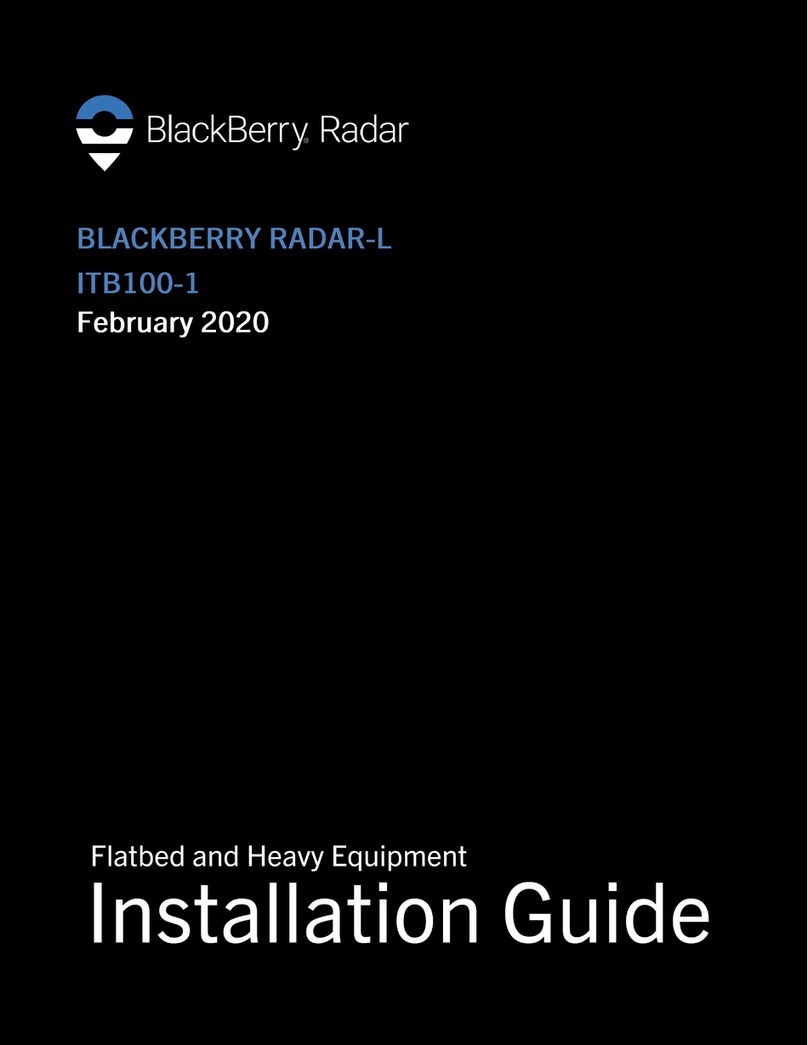
Blackbe;rry
Blackbe;rry RADAR-L installation guide

Blackbe;rry
Blackbe;rry RADAR H2 ITC100-1 installation guide
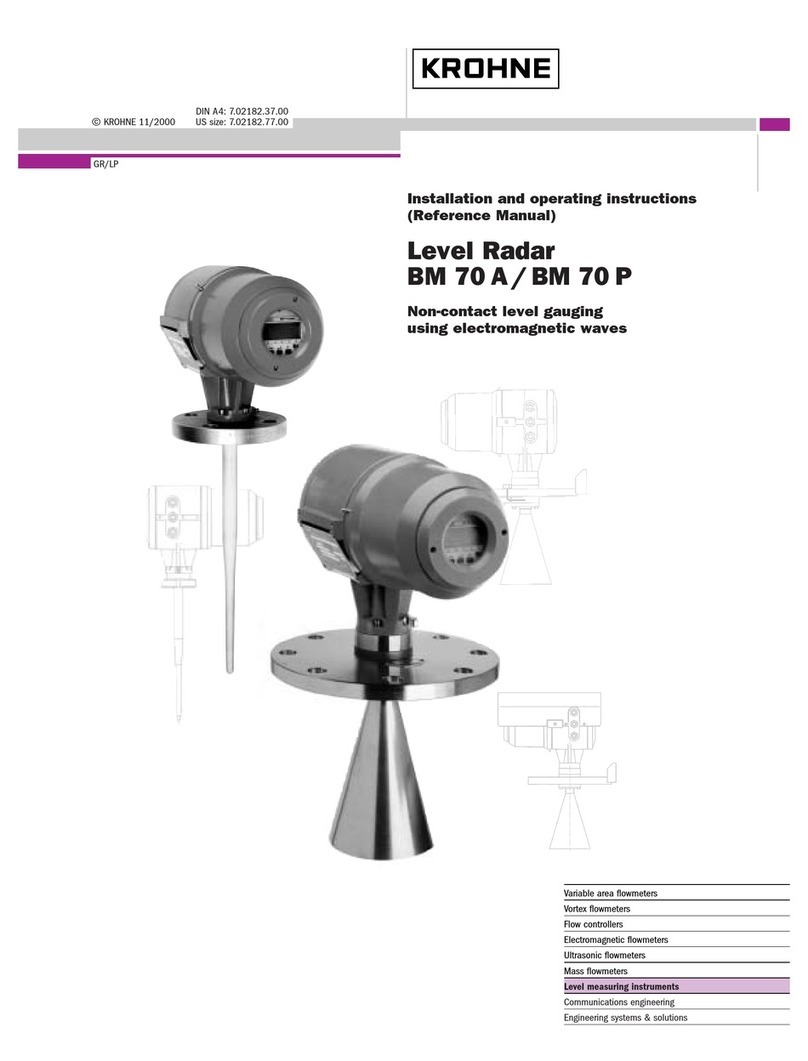
KROHNE
KROHNE BM 70 A Installation and operating instructions

JUGS
JUGS Pro-Sports R2000 owner's manual

Metrici
Metrici Observer Radar user guide

Endress+Hauser
Endress+Hauser Micropilot FMR20 operating instructions
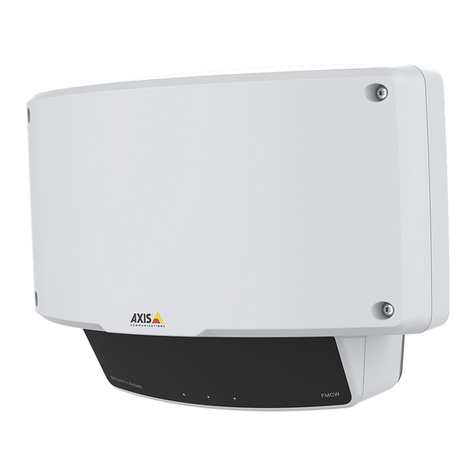
Axis
Axis D2110-VE user manual
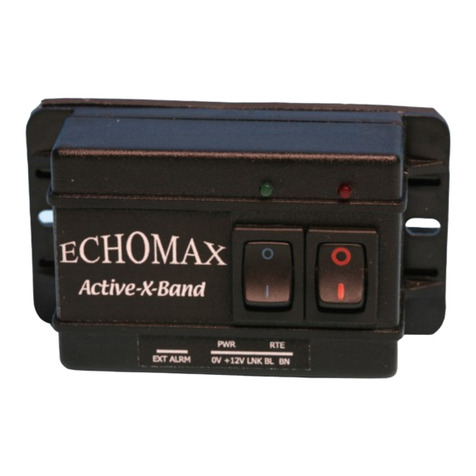
ECHOMAX
ECHOMAX Active-X-Band manual
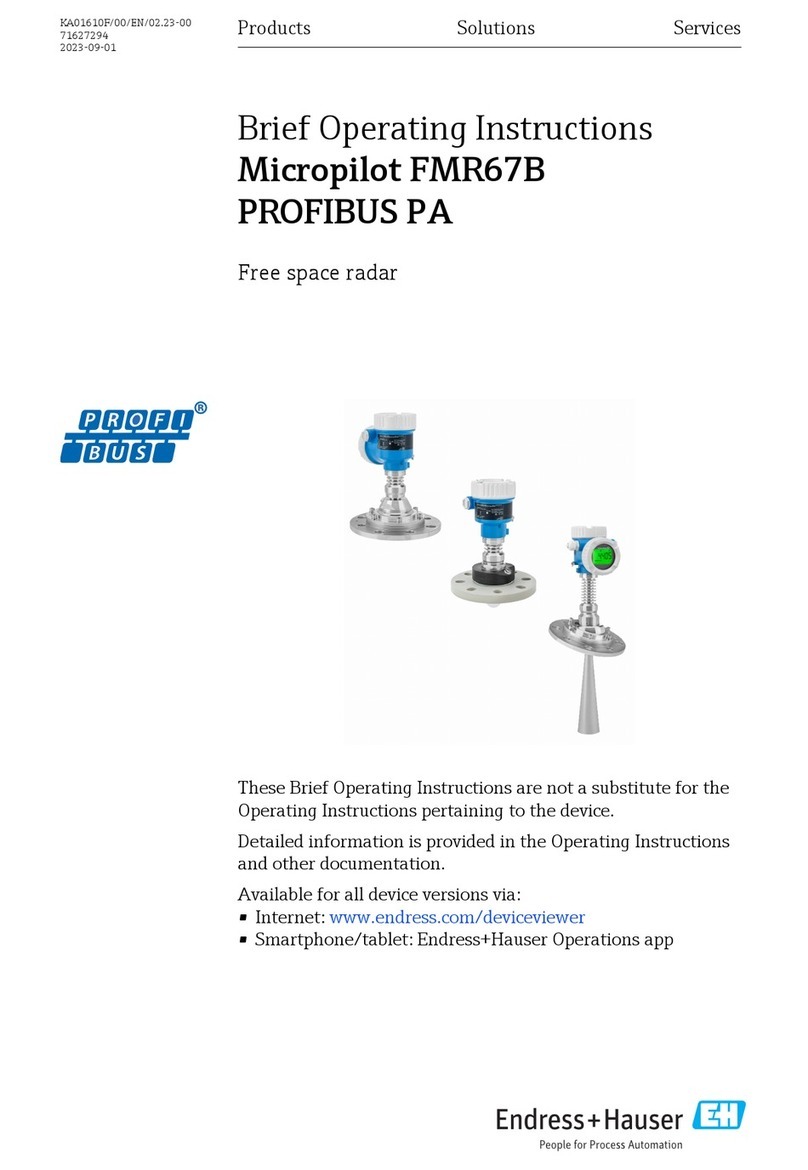
Endress+Hauser
Endress+Hauser Micropilot FMR67B Brief operating instructions

Raymarine
Raymarine Quantum Radome installation instructions

Endress+Hauser
Endress+Hauser Micropilot FMR20 Brief operating instructions
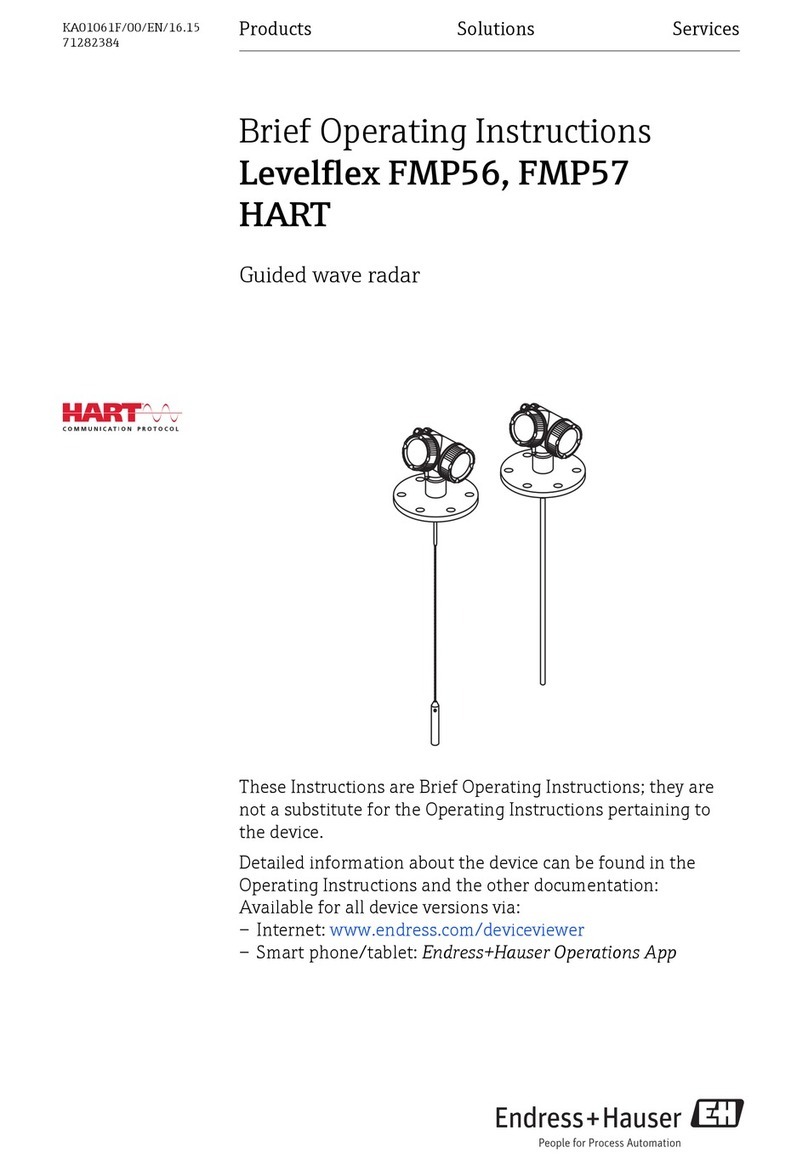
Endress+Hauser
Endress+Hauser Levelflex FMP56 Brief operating instructions
